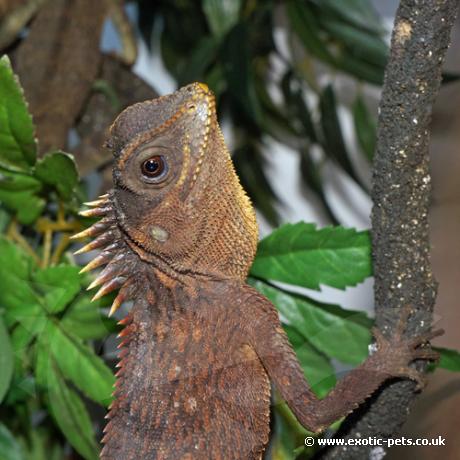

Mountain Horned Dragons are full of character and can easily be tamed down with a little time and patience. These beautiful creatures make an extremely good species for the novice and also the more experienced keeper.
| Origin | Burma, Thailand, Cambodia, Vietnam |
|---|---|
| Environment | Humid Forests |
| Adult Size | 12inches |
| Suitability | Intermediate |
| Lifespan | 8 Years + |
| Temperament | Docile but Skittish |
The Mountain Horned Dragon is a medium sized lizard, adults reach a size around 300mm (12") snout to vent. They generally have a grey background colour with orange/red markings, others tend to be more yellow. Each individual animal varies in colour. They have large orange/red eyes, large noticeable spines present on the nape (back of the neck) with smaller spines running along their back towards the tail.
Found in humid forests, these tree dwelling species range from Burma, Thailand, Northern Malaysian Peninsula, Cambodia and Southern Vietnam.
Being an arboreal lizard (tree dwelling), the vivarium should be tall rather then long. Provide a minimum height of 3-4ft, length 3ft and width of 1.5-2ft. As with most reptiles, the larger the vivarium, the happier the animal/s will be. If you are planning on keeping more than one, ensure you calculate the size accordingly.
The best substrate to use has to be the compressed coconut bedding - when water is added this swells and holds moisture in. This is excellent to keep the humidity levels high, as Mountain Horned Dragons require humidity at 70-80%. Misting twice a day can also help achieve the required levels. Another affective method is the use of a fogger. Place this on a timer to become active an hour before the lights turn on and an hour before they go off. It gives a very nice effect within the vivarium.
This species needs to be kept cool and the ideal daytime temperature should range between 25C (78F) to 27C (81F). Provide basking areas above branches, but never allow the temperature to exceed 30C (86F) throughout the vivarium. Allow a nighttime temperature of 21C (70F). To help control the temperature within the Vivarium use a Thermostat. The use of a UV light is very important, this helps your Mountain Horned Dragon produce the vitamin D3 it requires. Although these are a forest dwelling species, we would recommend the use of a 5% UV light.
Water should be provided in a large water dish/container so that they may have a soak if required. It is important that the water is moving, as they do not recognize still water. You can achieve this by using an air stone attached to a pump or for a better affect, build a small waterfall inside the large water container. Dehydration is a big issue with these lizards, but if you take these steps you shouldn't have any problems.
For décor, provide large thick branches with live or artificial plants. The latter is cheaper, but real plants make the vivarium look natural and I’m sure your Mountain Horned Dragon will appreciate this more. The best plants to use are Orchids, Tilandsia, Ferns, Bromeliads, Pothos, Philodendrons, Peperomias, Palms, and many others. Ensure you do not place any poisonous plants in the enclosure. Although the Dragon will not eat the plants, insects may! Stronger plants are better as these will be climb on.
These lizards are Insectivores; feed them on Crickets, Locusts, Mealworms, Wax Worms and the other insects you may find like small spiders. Mountain Horned Dragons love earthworms! These are high in calcium and nutrients and are very cheap to purchase from bait shops if you cannot find them in your garden. You can offer the worms every day with the odd cricket/locust to keep them actively hunting for live foods, you must be careful not to over feed them.